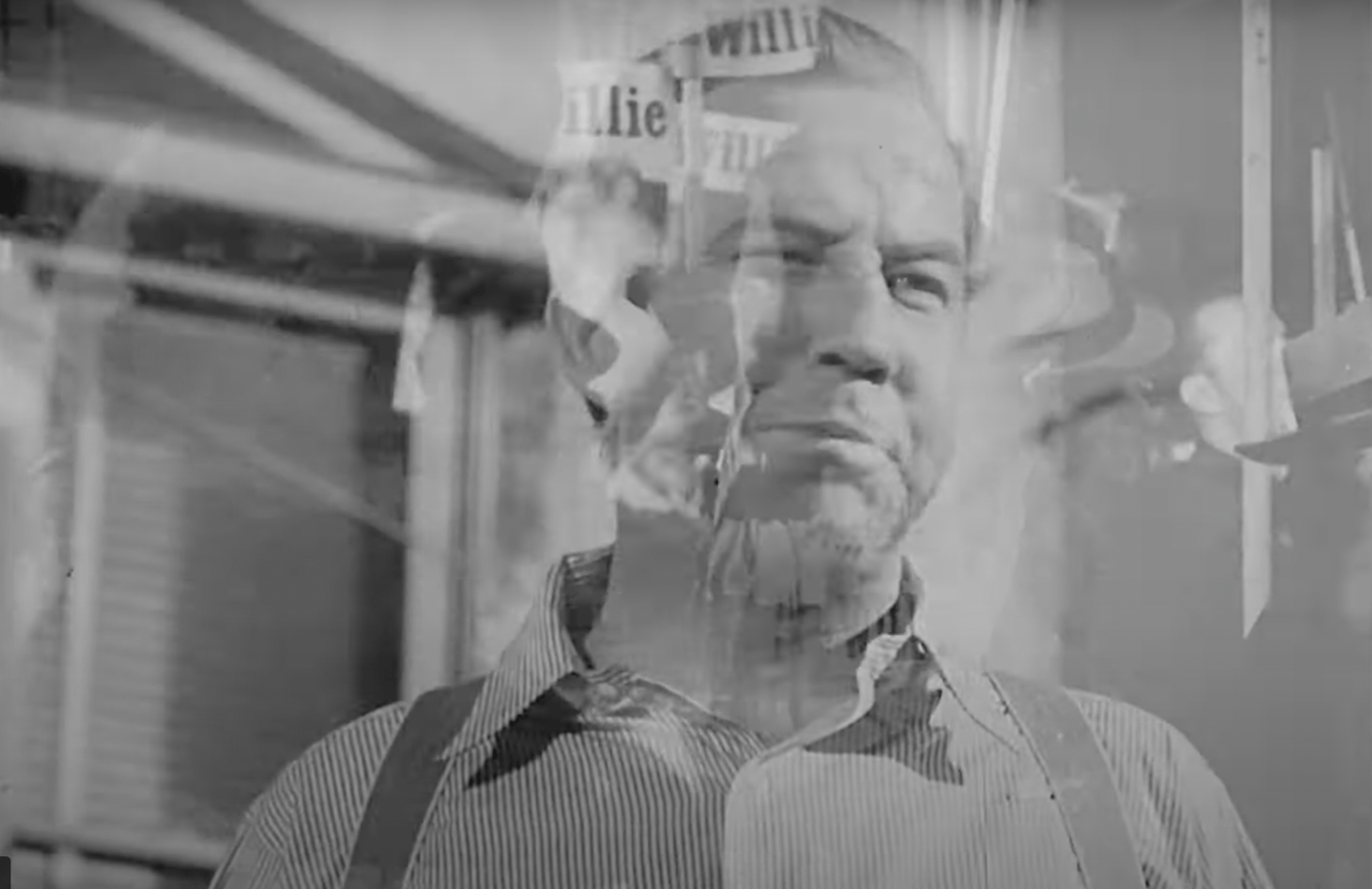Demagogues Three: Charles Foster Kane,Willie Stark, and Tucker Carlson

Broderick Crawford in All the King’s Men, Robert Rossen, director 1949. Screen shot.
Movie demagogues
The firing of Tucker Carlson by the Fox Corporation is a peculiarly American kind of denouement. A person born into wealth and influence, pushes, scrambles, and bullies to secure more of each, convinced they are his birthright. This being the United States, he quickly discovers that the best way to gain a mass following and the rewards that come with it is to embrace nativism or fascism. He does so and rises to a pinnacle of influence. But just as quickly as he rose to atmospheric heights, he falls back to earth like Icarus, punished for flying too close to the sun. That’s the fictional Charles Foster Kane and Willie Stark, and the TV personality Tucker Carlson, recently made redundant by Rupert Murdoch.
Narratives about demagogues comprise a significant sub-genre of American cinema. They include Citizen Kane (1941), All the King’s Men (1949), A Face in the Crowd (1957), Elmer Gantry (1960), The Manchurian Candidate (1962) and Seven Days in May (1964). All were directed by progressive directors schooled in the communist or Popular Front politics of the Great Depression and supported by an industry that allowed (up to a point) social justice concerns into screenplays. These films were more formally ambitious than standard Hollywood fare, with significant use of experimental and documentary-style devices, including montage, double-exposure, agitated or hand-held camera-work, and voice-overs that provide a critical meta-narrative.

Citizen Kane, Orson Welles, director, 1941. Screen shot.
Citizen Kane, the first great exemplar of the “demagogue-genre”, is exceptional by virtue of its foundation in European modernism. It deploys filmic devices learned from German Expressionism, the Soviet avant-garde, and Surrealism. It’s protagonist, however, modeled on William Randolph Hearst (among others), is typical Hollywood fare in that his politics are muddled in order not to alienate studio heads or potential audiences.
Welles was a lifelong man of the left and crusader for civil rights, listed in Red Channels, the anti-communist pamphlets published in the early ‘50s. But his film focusses more on bildung, the psychological formation of Kane, and his eventual self-destruction, than it does on ideology. Reared by a guardian concerned about his wealth but not his emotional well-being, Kane never understood how to love or be loved. The last word he uttered was “Rosebud,” the name of the sled he owned as a seven-year-old, before he was given over to the care of his guardian. Citizen Kane is not about the anti-union or anti-communist activities of Hearst, his early approval of Hitler and Mussolini, or his bankrolling the red scare that eventually swept up Hollywood writers and directors like Welles himself in the late ‘40s early 1950s. It’s about lonliness.
The second film mentioned above, and a model for the rest that followed, was All the King’s Men, directed by Robert Rossen and starring Broderick Crawford. While it too lacks political incisiveness — for which reason it was condemned by the Los Angeles Communist Party and The Daily Worker — it was sufficiently potent in its callout of American fascism that it cost its director dearly.
The story, based on a novel by Robert Penn Warren, concerns a demagogic politician, named Willie Stark who rises from humble origins to become governor of an unnamed state in the U.S. South. (The fictional character was loosely based upon populist Louisiana governor Huey Long.) Initially driven by a desire to help the downtrodden, he becomes ever more selfish, corrupt, and power mad as he rises in office. By the end of the film, he has sacrificed everything and everyone he ever cared about, including his adopted son Tommy, for the sake of power. Facing impeachment, Willie repeatedly tells his followers: “It’s not me they are after, it’s you.” A voiceover adds: “Willie knew that if you shout long enough, loud enough, and often enough, people start to believe you.”
That narration may have been Rossen’s political undoing. It invoked Adolph Hitler’s Mein Kampf: “In the big lie there is always a certain force of credibility; because the broad masses of a nation… in the primitive simplicity of their minds, more readily fall victims to the big lie than the small lie, since they themselves often tell small lies in little matters but would be ashamed to resort to large-scale falsehoods.” In 1951 and again in 1953, Rossen, a Jew and former member of the Communist Party, was called to testify before the House Un-American Activities Committee investigations of communists in the film industry. During his first appearance, he refused to name names and was promptly blacklisted. Two years later, he acceded to HUAC and studio demands and named 57 Hollywood actors, directors, and screenwriters as communists. He got his career back and later directed Paul Newman in The Hustler (1961) for which both director and actor were nominated for Academy Awards. He died in 1966 at age 57, planning a return to the socially conscious filmmaking of his youth.
American fascism
Films belonging to the demagogue genre, as we have seen, were based on biographic and historical facts. But the films left some important ones out: Fascist demagogues did not arise suddenly in the 1930s; they were part of a long, ignoble American tradition. The first American fascists were plantation owners who put their most valuable commodities — Black human beings — to work picking cotton, harvesting sugar cane, and generally building the wealth that allowed a new nation to compete in a global, capitalist market. Later, after the Civil War and Reconstruction, some fascists proudly sported white robes and hoods. They posed for snapshots at lynchings, wrote about the “Lost Cause,” applauded Birth of a Nation (D.W. Griffith, 1915), and published books titled The Passing of the Great Race (Madison Grant, 1916) and The Rising Tide of Color Against White World Supremacy (Lothrop Stoddard, 1920). These books deeply influenced Nazi racial theorist Alfred Rosenberg and Hitler himself. American fascists were not mere epigones – they were the avant-garde of fascism.
By the mid 1930s, links between American, German, and Italian fascism were clear. Dozens of U.S. organizations, including The Black Legion and the German-American Bund espoused Nazi principles and trumpeted hatred for Blacks and Jews. In 1936, Father Charles Coughlin, a popular radio personality, proclaimed “I take the road of fascism.” At the peak of his influence in 1932-34, he had as many as 30 million radio listeners per week in a nation of 120 million. Just a small minority of them, as Philip Roth wrote in The Plot Against America, listened in horror.
In 1940, the isolationist and anti-Semitic “America First” Committee was formed by Charles Lindberg. The slogan was already well known. It had been used by nativists, xenophobes, and eugenicists for more than 20 years and even adorned banners carried by the KKK. It signaled

Charles Lindberg’s address at America First rally, Manhattan Center, April 24, 1941. Screen shot.
support for European fascism. At an America First rally in Des Moines on September 11, 1941, Lindberg uttered a not so veiled threat to American Jews who supported U.S. entry into the war:
“The three most important groups who have been pressing this country toward war are the British, the Jewish and the Roosevelt administration…. No person with a sense of the dignity of mankind can condone the persecution of the Jewish race in Germany. But no person of honesty and vision can look on their pro-war policy here today without seeing the dangers involved in such a policy both for us and for them. Instead of agitating for war, the Jewish groups in this country should be opposing it in every possible way for they will be among the first to feel its consequences.”
“Tolerance is a virtue that depends upon peace and strength. History shows that it cannot survive war and devastations. A few far-sighted Jewish people realize this and stand opposed to intervention. But the majority still do not. Their greatest danger to this country lies in their large ownership and influence in our motion pictures, our press, our radio, and our government.”
A few months later, after the attack on Pearl Harbor, and the U.S. declaration of war against Germany and Japan, the America First movement began to collapse. The public saw Lindberg and his followers as unpatriotic at best and traitors at worst. Formerly sympathetic politicians now gave them the cold shoulder. But the demurral was not permanent.
Trump and Carlson
In 2016, fascism returned to the U.S. in the person of Donald Trump. He repeated the phrase “America First” like it was a mantra. It was a major theme in his first inaugural address; it became inscribed in national security documents and was trumpeted in his annual budget proposals. Nevertheless, Trump consistently supported large increases in military spending in preparation for foreign interventions. Alongside his pseudo-isolationism came nativism, racism, sexism, homophobia, and denigration of democracy. He rejected a free press, the rule of law, and an interest-free bureaucracy which he called “the deep state.” The Republican Party, of which Trump was titular head, proclaimed: “the Republican Party has and will continue to enthusiastically support the President’s America-first agenda.”
With the enthusiastic cooperation of Rupert Murdoch, Trump established Fox News as a quasi-official propaganda office while attacking journalists elsewhere as “enemies of the people.” Tucker Carlson became Trump’s Goebbels, his unofficial propaganda minister. The two shared both ideas and rhetorical strategies. One of these was “the Great Replacement Theory,” the idea that illegal immigration into the U.S. was abetted by Democratic politicians and their supporters for the purpose of replacing “legacy Americans”, as Carlson put it, with “more obedient voters from the third world.” It’s an idea that dates to the “racial suicide” theory deployed by racist and eugenicist opponents of Irish Catholic, Italian and Eastern European immigration in the late 19th century. (The term “legacy Americans” comes from the white supremacist website VDARE.)
On his former platform, “Tucker Carlson Tonight,” the broadcaster spoke about racial replacement more than 400 hundred times, according to a NYTimes tally in 2022. Here are a few examples:
“[Democrats] can either embrace the issues the middle-class cares about, or they can import an entirely new electorate from the Third World and change the demographics of the U.S. so completely they’ll never lose again.”
“Dramatic demographic change means many Americans don’t recognize where they grew up.”
“As with illegal immigration, the long-term agenda of refugee resettlement is to bring in future Democratic voters.”
“Illegal immigrants are the key to their power.”
Trump didn’t need coaxing from Carlson to deploy replacement and other white supremacist themes in his speeches, ads and tweets. He has used such language since his early days in the real estate business in New York City. But since 2016, the rhetoric has been supercharged as many observers have documented. He has referred to Muslims as “invaders”, decried immigration from Black, “shithole” countries, and called Mexican migrants rapists. At a rally last year, Trump pledged to “take back that beautiful, beautiful house that happens to be white” The Wikipedia page dedicated to “Racial Views of Donald Trump” extends to more than 32,000 words, including 457 endnotes; it’s not happy reading.
The address of demagogues
In All the King’s Men, as noted earlier, Willie deploys direct-address (second person speech) to rally his followers. “It’s not me they are after, it’s you.” The purpose of such rhetoric is to seize listeners’ attention and encourage them to feel a personal connection to the speaker. Willie’s specific aim is to make his followers so closely identify with him, that they will feel that an attack on him – in this case impeachment — is an attack on them. It’s what Trump did during his own impeachments and his address at on January 6 prior to the insurrection: “And we fight. We fight like hell. And if you don’t fight like hell, you’re not going to have a country anymore.”
Direct-address is Carlson’s veritable trademark:
“They want to control what you do.”
“They care more about identity politics than they do about your life.”
“They care more about preventing a border wall than they do about raising your wages.”
“They care about Afghans far more than they care about you.”
“They Hate you.”
“They want to hurt you.”
NYTimes reporters have documented how Tucker Carlson, like “populist or authoritarian leaders” deploys the language of “they/you” to establish “emotional connections” with their followers. The “they” is frequently “the ruling class,” an ever-shifting population of Democrats, liberals, Black people, LGBTQ activists, capitalists (especially George Soros) , gun control advocates, communists, the Clintons, media executives, and Silicon Valley billionaires. Like prior generations of fascists and national socialists, Carlson co-ops the language of the left – “the ruling class” – to construe his audience as victims whom he alone can rescue.
Now Carlson is off the air, but that offers only partial solace. Unlike previous fascists and demagogues, including Coughlin, Lindberg, Joe McCarthy, Barry Goldwater and George Wallace, Carlson was not rejected by a cross section or Americans or elected politicians. It was not his racism, misogyny, anti-Semitism, anti-LGBTQ bias, or conspiratorialism that got him booted off Fox. It was his off-camera vulgarity, disrespect for Fox executives and the Murdoch family and exposure of the Fox Corporation to expensive legal settlements. Deprived of his large and loyal audience on cable TV (he was earlier fired by CNN and MSNBC), his best option for regaining it is politics. The question is only whether he will chart his course according to the star of Donald Trump (vice presidential candidate?) or some other demagogue, real or fictional.











